MKT00720 Case Study: Marketing Strategies of Coca-Cola & PepsiCo
VerifiedAdded on 2022/10/11
|9
|2160
|13
Case Study
AI Summary
This report presents a comprehensive case study analysis of the marketing practices employed by Coca-Cola and PepsiCo. The introduction sets the stage by discussing the core principles of market theory and the dynamics of exchange. The analysis delves into Coca-Cola's branding and positioning strategies, highlighting their success in building brand equity and adapting to market changes, including their diverse product portfolio and effective marketing campaigns. The report then examines PepsiCo's marketing practices, focusing on the 4 Ps of the marketing mix: product, price, promotion, and place. It details how PepsiCo utilizes these elements to target its diverse consumer base and maintain a competitive edge. The conclusion summarizes the key findings, emphasizing the importance of strategic marketing in achieving market dominance for both companies.
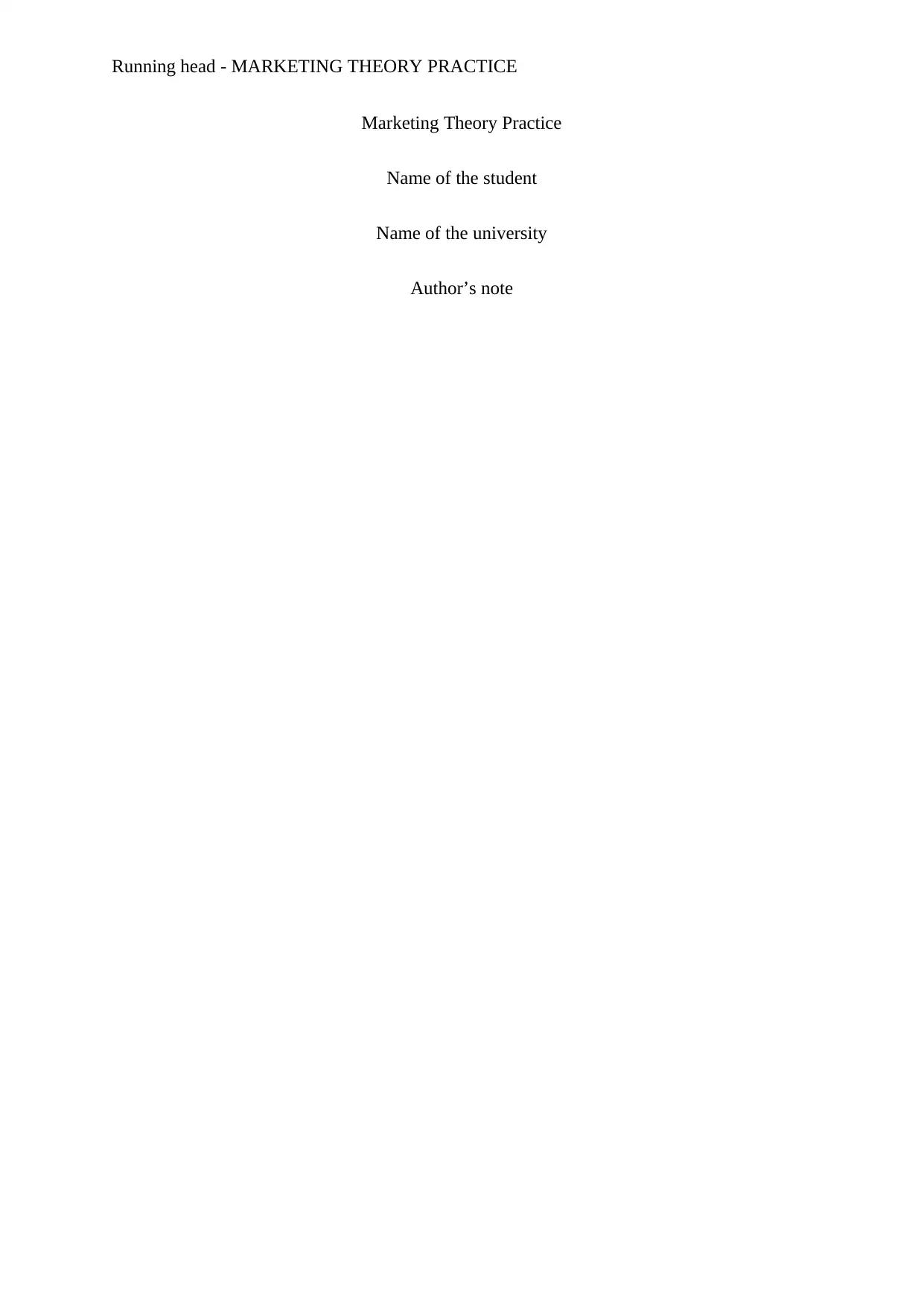
Running head - MARKETING THEORY PRACTICE
Marketing Theory Practice
Name of the student
Name of the university
Author’s note
Marketing Theory Practice
Name of the student
Name of the university
Author’s note
Paraphrase This Document
Need a fresh take? Get an instant paraphrase of this document with our AI Paraphraser
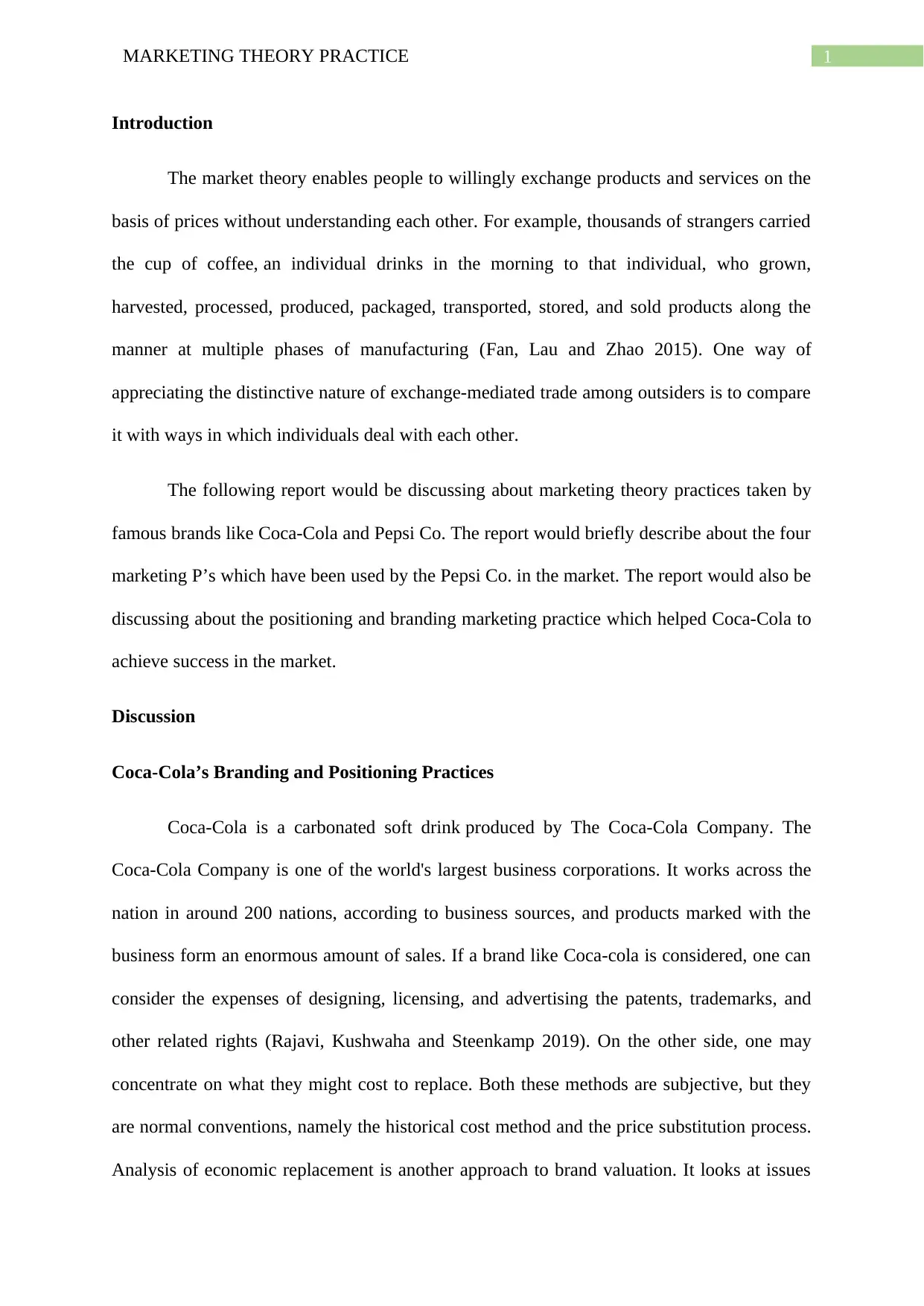
1MARKETING THEORY PRACTICE
Introduction
The market theory enables people to willingly exchange products and services on the
basis of prices without understanding each other. For example, thousands of strangers carried
the cup of coffee, an individual drinks in the morning to that individual, who grown,
harvested, processed, produced, packaged, transported, stored, and sold products along the
manner at multiple phases of manufacturing (Fan, Lau and Zhao 2015). One way of
appreciating the distinctive nature of exchange-mediated trade among outsiders is to compare
it with ways in which individuals deal with each other.
The following report would be discussing about marketing theory practices taken by
famous brands like Coca-Cola and Pepsi Co. The report would briefly describe about the four
marketing P’s which have been used by the Pepsi Co. in the market. The report would also be
discussing about the positioning and branding marketing practice which helped Coca-Cola to
achieve success in the market.
Discussion
Coca-Cola’s Branding and Positioning Practices
Coca-Cola is a carbonated soft drink produced by The Coca-Cola Company. The
Coca-Cola Company is one of the world's largest business corporations. It works across the
nation in around 200 nations, according to business sources, and products marked with the
business form an enormous amount of sales. If a brand like Coca-cola is considered, one can
consider the expenses of designing, licensing, and advertising the patents, trademarks, and
other related rights (Rajavi, Kushwaha and Steenkamp 2019). On the other side, one may
concentrate on what they might cost to replace. Both these methods are subjective, but they
are normal conventions, namely the historical cost method and the price substitution process.
Analysis of economic replacement is another approach to brand valuation. It looks at issues
Introduction
The market theory enables people to willingly exchange products and services on the
basis of prices without understanding each other. For example, thousands of strangers carried
the cup of coffee, an individual drinks in the morning to that individual, who grown,
harvested, processed, produced, packaged, transported, stored, and sold products along the
manner at multiple phases of manufacturing (Fan, Lau and Zhao 2015). One way of
appreciating the distinctive nature of exchange-mediated trade among outsiders is to compare
it with ways in which individuals deal with each other.
The following report would be discussing about marketing theory practices taken by
famous brands like Coca-Cola and Pepsi Co. The report would briefly describe about the four
marketing P’s which have been used by the Pepsi Co. in the market. The report would also be
discussing about the positioning and branding marketing practice which helped Coca-Cola to
achieve success in the market.
Discussion
Coca-Cola’s Branding and Positioning Practices
Coca-Cola is a carbonated soft drink produced by The Coca-Cola Company. The
Coca-Cola Company is one of the world's largest business corporations. It works across the
nation in around 200 nations, according to business sources, and products marked with the
business form an enormous amount of sales. If a brand like Coca-cola is considered, one can
consider the expenses of designing, licensing, and advertising the patents, trademarks, and
other related rights (Rajavi, Kushwaha and Steenkamp 2019). On the other side, one may
concentrate on what they might cost to replace. Both these methods are subjective, but they
are normal conventions, namely the historical cost method and the price substitution process.
Analysis of economic replacement is another approach to brand valuation. It looks at issues
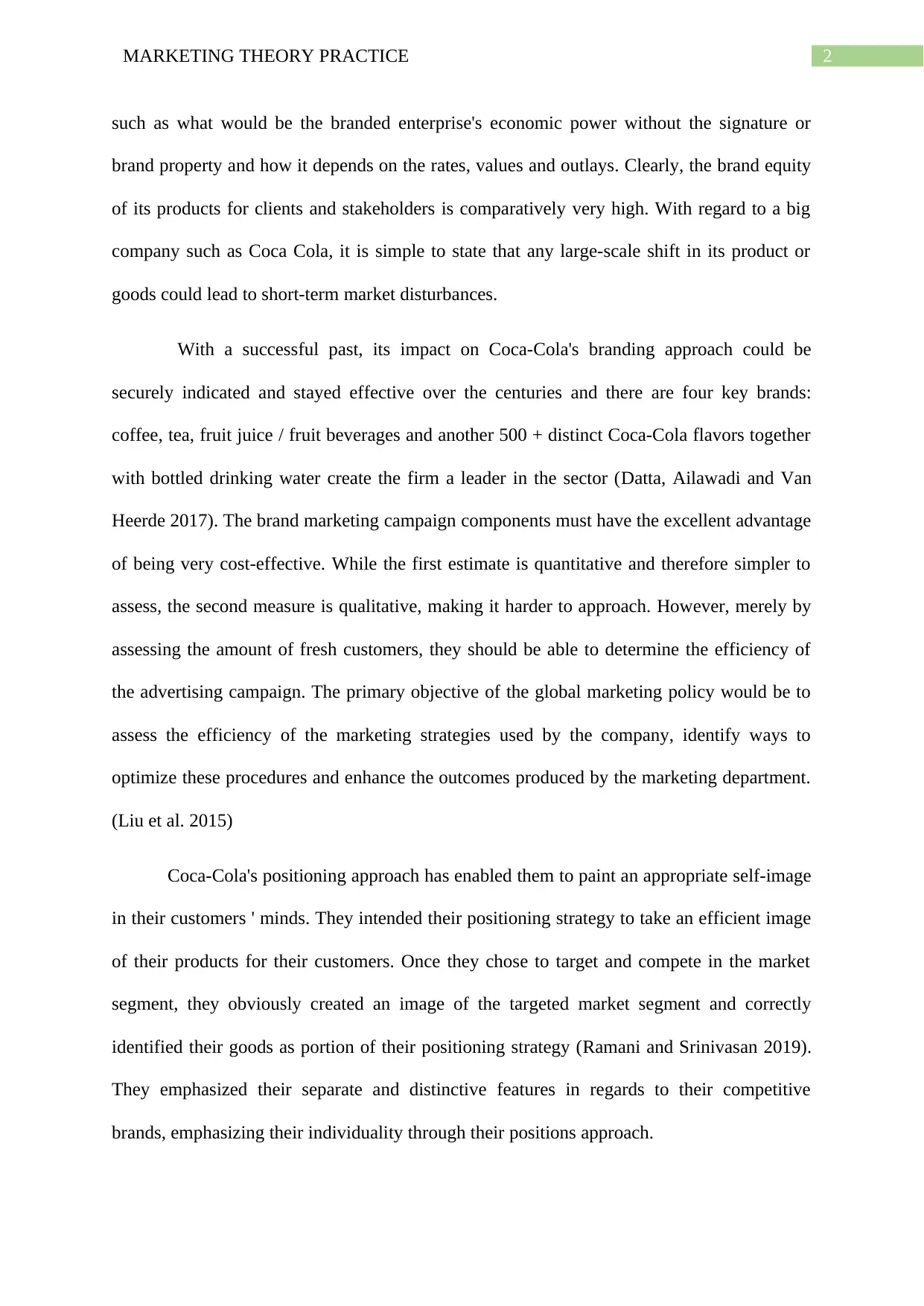
2MARKETING THEORY PRACTICE
such as what would be the branded enterprise's economic power without the signature or
brand property and how it depends on the rates, values and outlays. Clearly, the brand equity
of its products for clients and stakeholders is comparatively very high. With regard to a big
company such as Coca Cola, it is simple to state that any large-scale shift in its product or
goods could lead to short-term market disturbances.
With a successful past, its impact on Coca-Cola's branding approach could be
securely indicated and stayed effective over the centuries and there are four key brands:
coffee, tea, fruit juice / fruit beverages and another 500 + distinct Coca-Cola flavors together
with bottled drinking water create the firm a leader in the sector (Datta, Ailawadi and Van
Heerde 2017). The brand marketing campaign components must have the excellent advantage
of being very cost-effective. While the first estimate is quantitative and therefore simpler to
assess, the second measure is qualitative, making it harder to approach. However, merely by
assessing the amount of fresh customers, they should be able to determine the efficiency of
the advertising campaign. The primary objective of the global marketing policy would be to
assess the efficiency of the marketing strategies used by the company, identify ways to
optimize these procedures and enhance the outcomes produced by the marketing department.
(Liu et al. 2015)
Coca-Cola's positioning approach has enabled them to paint an appropriate self-image
in their customers ' minds. They intended their positioning strategy to take an efficient image
of their products for their customers. Once they chose to target and compete in the market
segment, they obviously created an image of the targeted market segment and correctly
identified their goods as portion of their positioning strategy (Ramani and Srinivasan 2019).
They emphasized their separate and distinctive features in regards to their competitive
brands, emphasizing their individuality through their positions approach.
such as what would be the branded enterprise's economic power without the signature or
brand property and how it depends on the rates, values and outlays. Clearly, the brand equity
of its products for clients and stakeholders is comparatively very high. With regard to a big
company such as Coca Cola, it is simple to state that any large-scale shift in its product or
goods could lead to short-term market disturbances.
With a successful past, its impact on Coca-Cola's branding approach could be
securely indicated and stayed effective over the centuries and there are four key brands:
coffee, tea, fruit juice / fruit beverages and another 500 + distinct Coca-Cola flavors together
with bottled drinking water create the firm a leader in the sector (Datta, Ailawadi and Van
Heerde 2017). The brand marketing campaign components must have the excellent advantage
of being very cost-effective. While the first estimate is quantitative and therefore simpler to
assess, the second measure is qualitative, making it harder to approach. However, merely by
assessing the amount of fresh customers, they should be able to determine the efficiency of
the advertising campaign. The primary objective of the global marketing policy would be to
assess the efficiency of the marketing strategies used by the company, identify ways to
optimize these procedures and enhance the outcomes produced by the marketing department.
(Liu et al. 2015)
Coca-Cola's positioning approach has enabled them to paint an appropriate self-image
in their customers ' minds. They intended their positioning strategy to take an efficient image
of their products for their customers. Once they chose to target and compete in the market
segment, they obviously created an image of the targeted market segment and correctly
identified their goods as portion of their positioning strategy (Ramani and Srinivasan 2019).
They emphasized their separate and distinctive features in regards to their competitive
brands, emphasizing their individuality through their positions approach.
⊘ This is a preview!⊘
Do you want full access?
Subscribe today to unlock all pages.

Trusted by 1+ million students worldwide
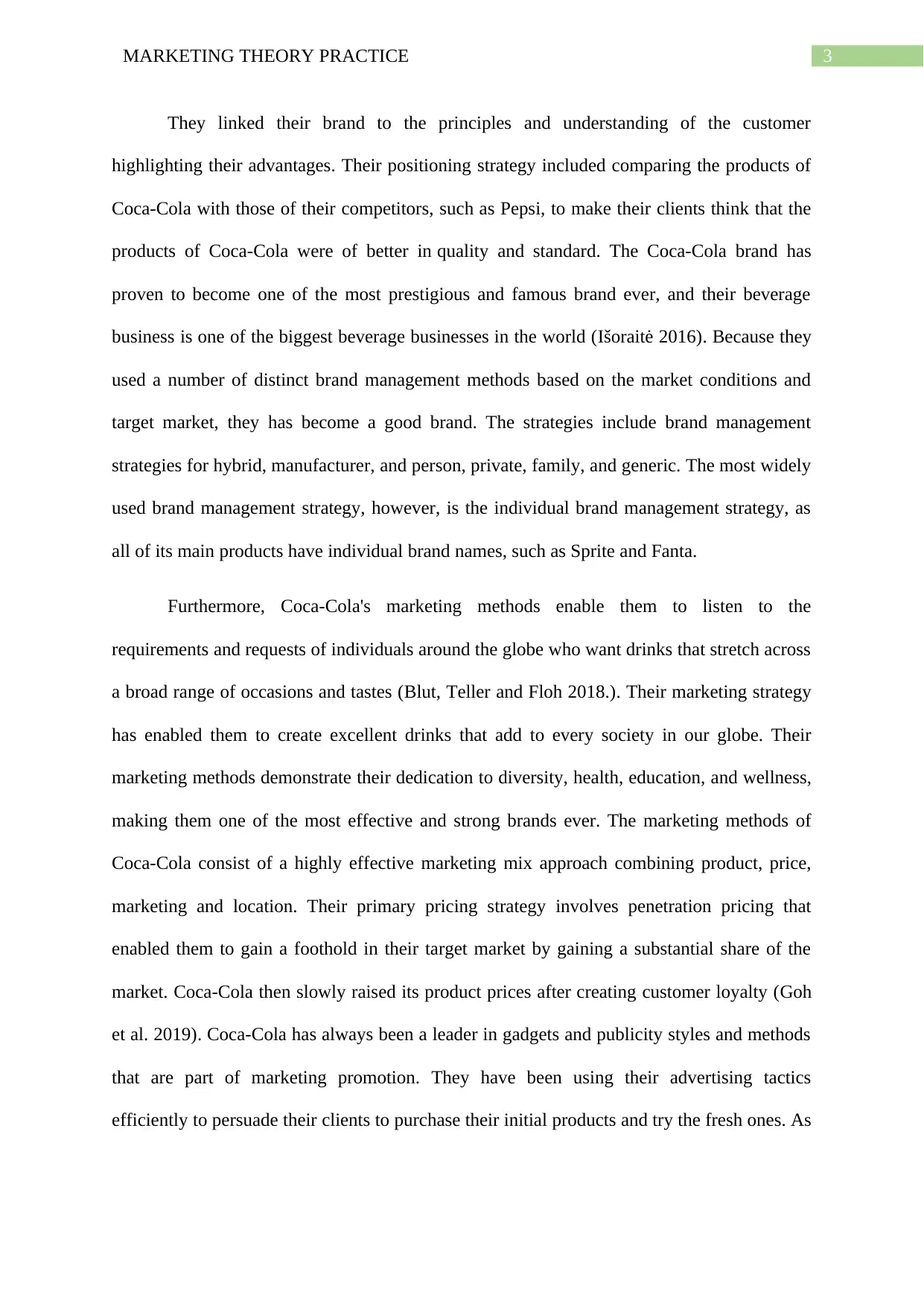
3MARKETING THEORY PRACTICE
They linked their brand to the principles and understanding of the customer
highlighting their advantages. Their positioning strategy included comparing the products of
Coca-Cola with those of their competitors, such as Pepsi, to make their clients think that the
products of Coca-Cola were of better in quality and standard. The Coca-Cola brand has
proven to become one of the most prestigious and famous brand ever, and their beverage
business is one of the biggest beverage businesses in the world (Išoraitė 2016). Because they
used a number of distinct brand management methods based on the market conditions and
target market, they has become a good brand. The strategies include brand management
strategies for hybrid, manufacturer, and person, private, family, and generic. The most widely
used brand management strategy, however, is the individual brand management strategy, as
all of its main products have individual brand names, such as Sprite and Fanta.
Furthermore, Coca-Cola's marketing methods enable them to listen to the
requirements and requests of individuals around the globe who want drinks that stretch across
a broad range of occasions and tastes (Blut, Teller and Floh 2018.). Their marketing strategy
has enabled them to create excellent drinks that add to every society in our globe. Their
marketing methods demonstrate their dedication to diversity, health, education, and wellness,
making them one of the most effective and strong brands ever. The marketing methods of
Coca-Cola consist of a highly effective marketing mix approach combining product, price,
marketing and location. Their primary pricing strategy involves penetration pricing that
enabled them to gain a foothold in their target market by gaining a substantial share of the
market. Coca-Cola then slowly raised its product prices after creating customer loyalty (Goh
et al. 2019). Coca-Cola has always been a leader in gadgets and publicity styles and methods
that are part of marketing promotion. They have been using their advertising tactics
efficiently to persuade their clients to purchase their initial products and try the fresh ones. As
They linked their brand to the principles and understanding of the customer
highlighting their advantages. Their positioning strategy included comparing the products of
Coca-Cola with those of their competitors, such as Pepsi, to make their clients think that the
products of Coca-Cola were of better in quality and standard. The Coca-Cola brand has
proven to become one of the most prestigious and famous brand ever, and their beverage
business is one of the biggest beverage businesses in the world (Išoraitė 2016). Because they
used a number of distinct brand management methods based on the market conditions and
target market, they has become a good brand. The strategies include brand management
strategies for hybrid, manufacturer, and person, private, family, and generic. The most widely
used brand management strategy, however, is the individual brand management strategy, as
all of its main products have individual brand names, such as Sprite and Fanta.
Furthermore, Coca-Cola's marketing methods enable them to listen to the
requirements and requests of individuals around the globe who want drinks that stretch across
a broad range of occasions and tastes (Blut, Teller and Floh 2018.). Their marketing strategy
has enabled them to create excellent drinks that add to every society in our globe. Their
marketing methods demonstrate their dedication to diversity, health, education, and wellness,
making them one of the most effective and strong brands ever. The marketing methods of
Coca-Cola consist of a highly effective marketing mix approach combining product, price,
marketing and location. Their primary pricing strategy involves penetration pricing that
enabled them to gain a foothold in their target market by gaining a substantial share of the
market. Coca-Cola then slowly raised its product prices after creating customer loyalty (Goh
et al. 2019). Coca-Cola has always been a leader in gadgets and publicity styles and methods
that are part of marketing promotion. They have been using their advertising tactics
efficiently to persuade their clients to purchase their initial products and try the fresh ones. As
Paraphrase This Document
Need a fresh take? Get an instant paraphrase of this document with our AI Paraphraser
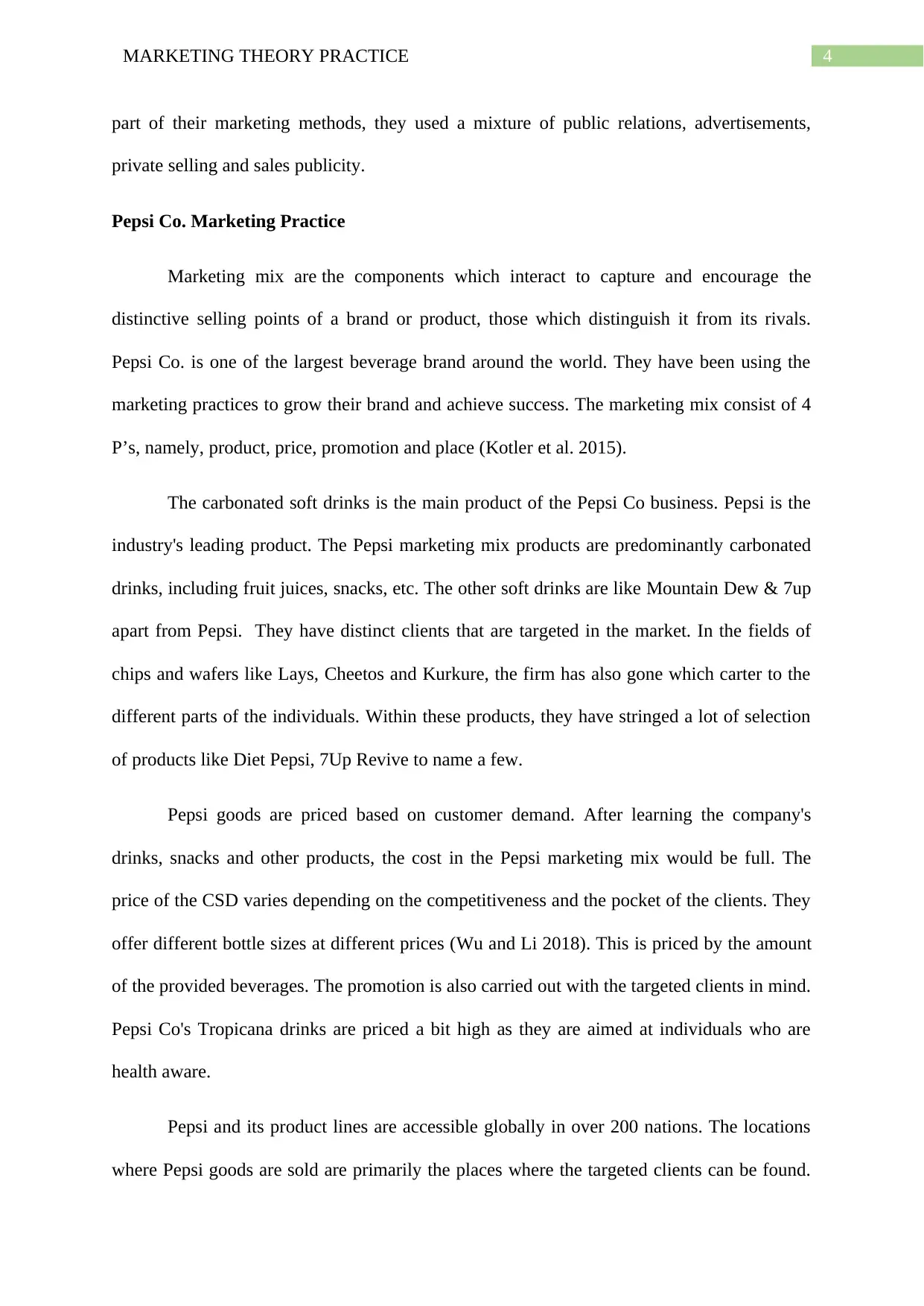
4MARKETING THEORY PRACTICE
part of their marketing methods, they used a mixture of public relations, advertisements,
private selling and sales publicity.
Pepsi Co. Marketing Practice
Marketing mix are the components which interact to capture and encourage the
distinctive selling points of a brand or product, those which distinguish it from its rivals.
Pepsi Co. is one of the largest beverage brand around the world. They have been using the
marketing practices to grow their brand and achieve success. The marketing mix consist of 4
P’s, namely, product, price, promotion and place (Kotler et al. 2015).
The carbonated soft drinks is the main product of the Pepsi Co business. Pepsi is the
industry's leading product. The Pepsi marketing mix products are predominantly carbonated
drinks, including fruit juices, snacks, etc. The other soft drinks are like Mountain Dew & 7up
apart from Pepsi. They have distinct clients that are targeted in the market. In the fields of
chips and wafers like Lays, Cheetos and Kurkure, the firm has also gone which carter to the
different parts of the individuals. Within these products, they have stringed a lot of selection
of products like Diet Pepsi, 7Up Revive to name a few.
Pepsi goods are priced based on customer demand. After learning the company's
drinks, snacks and other products, the cost in the Pepsi marketing mix would be full. The
price of the CSD varies depending on the competitiveness and the pocket of the clients. They
offer different bottle sizes at different prices (Wu and Li 2018). This is priced by the amount
of the provided beverages. The promotion is also carried out with the targeted clients in mind.
Pepsi Co's Tropicana drinks are priced a bit high as they are aimed at individuals who are
health aware.
Pepsi and its product lines are accessible globally in over 200 nations. The locations
where Pepsi goods are sold are primarily the places where the targeted clients can be found.
part of their marketing methods, they used a mixture of public relations, advertisements,
private selling and sales publicity.
Pepsi Co. Marketing Practice
Marketing mix are the components which interact to capture and encourage the
distinctive selling points of a brand or product, those which distinguish it from its rivals.
Pepsi Co. is one of the largest beverage brand around the world. They have been using the
marketing practices to grow their brand and achieve success. The marketing mix consist of 4
P’s, namely, product, price, promotion and place (Kotler et al. 2015).
The carbonated soft drinks is the main product of the Pepsi Co business. Pepsi is the
industry's leading product. The Pepsi marketing mix products are predominantly carbonated
drinks, including fruit juices, snacks, etc. The other soft drinks are like Mountain Dew & 7up
apart from Pepsi. They have distinct clients that are targeted in the market. In the fields of
chips and wafers like Lays, Cheetos and Kurkure, the firm has also gone which carter to the
different parts of the individuals. Within these products, they have stringed a lot of selection
of products like Diet Pepsi, 7Up Revive to name a few.
Pepsi goods are priced based on customer demand. After learning the company's
drinks, snacks and other products, the cost in the Pepsi marketing mix would be full. The
price of the CSD varies depending on the competitiveness and the pocket of the clients. They
offer different bottle sizes at different prices (Wu and Li 2018). This is priced by the amount
of the provided beverages. The promotion is also carried out with the targeted clients in mind.
Pepsi Co's Tropicana drinks are priced a bit high as they are aimed at individuals who are
health aware.
Pepsi and its product lines are accessible globally in over 200 nations. The locations
where Pepsi goods are sold are primarily the places where the targeted clients can be found.
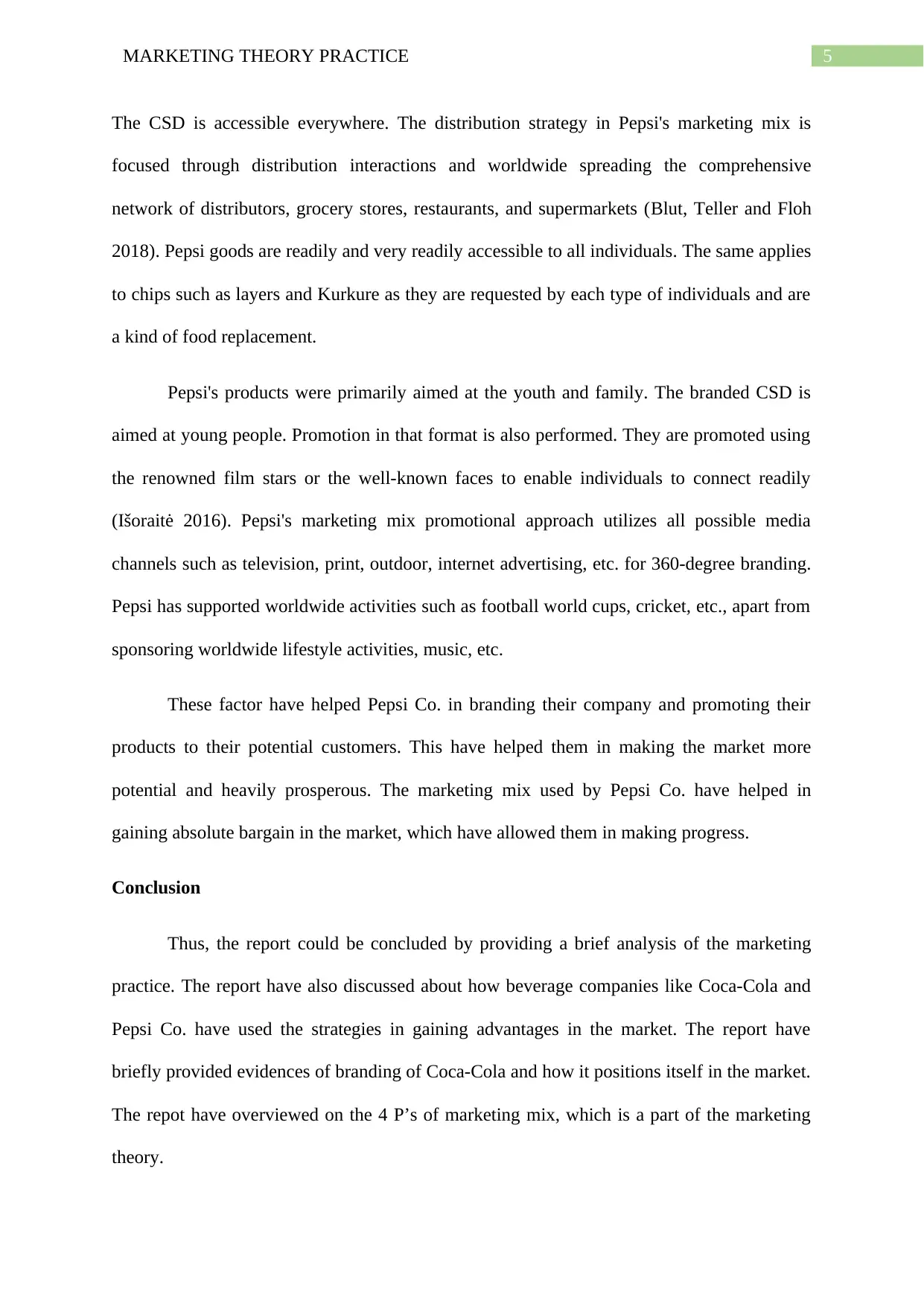
5MARKETING THEORY PRACTICE
The CSD is accessible everywhere. The distribution strategy in Pepsi's marketing mix is
focused through distribution interactions and worldwide spreading the comprehensive
network of distributors, grocery stores, restaurants, and supermarkets (Blut, Teller and Floh
2018). Pepsi goods are readily and very readily accessible to all individuals. The same applies
to chips such as layers and Kurkure as they are requested by each type of individuals and are
a kind of food replacement.
Pepsi's products were primarily aimed at the youth and family. The branded CSD is
aimed at young people. Promotion in that format is also performed. They are promoted using
the renowned film stars or the well-known faces to enable individuals to connect readily
(Išoraitė 2016). Pepsi's marketing mix promotional approach utilizes all possible media
channels such as television, print, outdoor, internet advertising, etc. for 360-degree branding.
Pepsi has supported worldwide activities such as football world cups, cricket, etc., apart from
sponsoring worldwide lifestyle activities, music, etc.
These factor have helped Pepsi Co. in branding their company and promoting their
products to their potential customers. This have helped them in making the market more
potential and heavily prosperous. The marketing mix used by Pepsi Co. have helped in
gaining absolute bargain in the market, which have allowed them in making progress.
Conclusion
Thus, the report could be concluded by providing a brief analysis of the marketing
practice. The report have also discussed about how beverage companies like Coca-Cola and
Pepsi Co. have used the strategies in gaining advantages in the market. The report have
briefly provided evidences of branding of Coca-Cola and how it positions itself in the market.
The repot have overviewed on the 4 P’s of marketing mix, which is a part of the marketing
theory.
The CSD is accessible everywhere. The distribution strategy in Pepsi's marketing mix is
focused through distribution interactions and worldwide spreading the comprehensive
network of distributors, grocery stores, restaurants, and supermarkets (Blut, Teller and Floh
2018). Pepsi goods are readily and very readily accessible to all individuals. The same applies
to chips such as layers and Kurkure as they are requested by each type of individuals and are
a kind of food replacement.
Pepsi's products were primarily aimed at the youth and family. The branded CSD is
aimed at young people. Promotion in that format is also performed. They are promoted using
the renowned film stars or the well-known faces to enable individuals to connect readily
(Išoraitė 2016). Pepsi's marketing mix promotional approach utilizes all possible media
channels such as television, print, outdoor, internet advertising, etc. for 360-degree branding.
Pepsi has supported worldwide activities such as football world cups, cricket, etc., apart from
sponsoring worldwide lifestyle activities, music, etc.
These factor have helped Pepsi Co. in branding their company and promoting their
products to their potential customers. This have helped them in making the market more
potential and heavily prosperous. The marketing mix used by Pepsi Co. have helped in
gaining absolute bargain in the market, which have allowed them in making progress.
Conclusion
Thus, the report could be concluded by providing a brief analysis of the marketing
practice. The report have also discussed about how beverage companies like Coca-Cola and
Pepsi Co. have used the strategies in gaining advantages in the market. The report have
briefly provided evidences of branding of Coca-Cola and how it positions itself in the market.
The repot have overviewed on the 4 P’s of marketing mix, which is a part of the marketing
theory.
⊘ This is a preview!⊘
Do you want full access?
Subscribe today to unlock all pages.

Trusted by 1+ million students worldwide
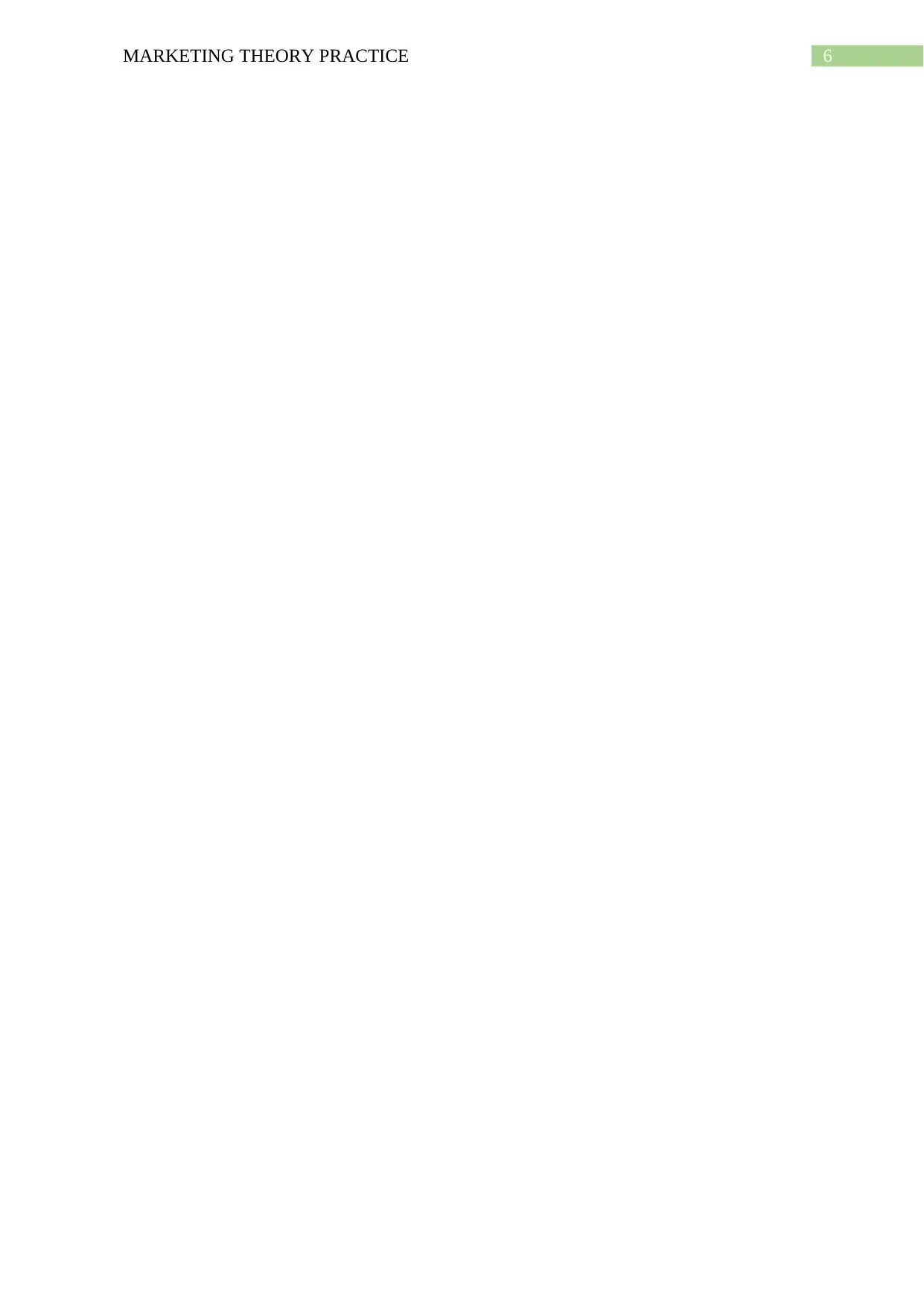
6MARKETING THEORY PRACTICE
Paraphrase This Document
Need a fresh take? Get an instant paraphrase of this document with our AI Paraphraser
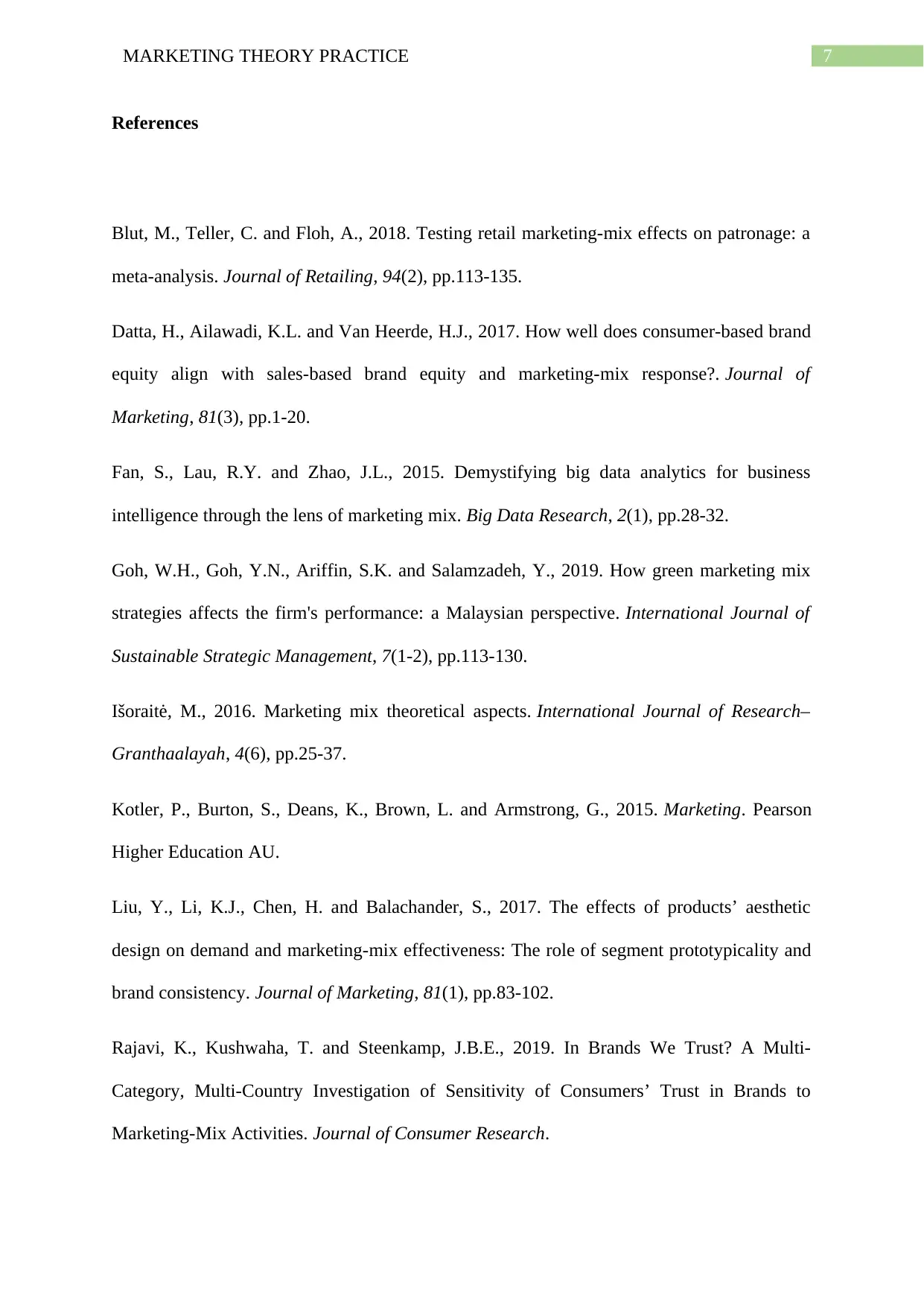
7MARKETING THEORY PRACTICE
References
Blut, M., Teller, C. and Floh, A., 2018. Testing retail marketing-mix effects on patronage: a
meta-analysis. Journal of Retailing, 94(2), pp.113-135.
Datta, H., Ailawadi, K.L. and Van Heerde, H.J., 2017. How well does consumer-based brand
equity align with sales-based brand equity and marketing-mix response?. Journal of
Marketing, 81(3), pp.1-20.
Fan, S., Lau, R.Y. and Zhao, J.L., 2015. Demystifying big data analytics for business
intelligence through the lens of marketing mix. Big Data Research, 2(1), pp.28-32.
Goh, W.H., Goh, Y.N., Ariffin, S.K. and Salamzadeh, Y., 2019. How green marketing mix
strategies affects the firm's performance: a Malaysian perspective. International Journal of
Sustainable Strategic Management, 7(1-2), pp.113-130.
Išoraitė, M., 2016. Marketing mix theoretical aspects. International Journal of Research–
Granthaalayah, 4(6), pp.25-37.
Kotler, P., Burton, S., Deans, K., Brown, L. and Armstrong, G., 2015. Marketing. Pearson
Higher Education AU.
Liu, Y., Li, K.J., Chen, H. and Balachander, S., 2017. The effects of products’ aesthetic
design on demand and marketing-mix effectiveness: The role of segment prototypicality and
brand consistency. Journal of Marketing, 81(1), pp.83-102.
Rajavi, K., Kushwaha, T. and Steenkamp, J.B.E., 2019. In Brands We Trust? A Multi-
Category, Multi-Country Investigation of Sensitivity of Consumers’ Trust in Brands to
Marketing-Mix Activities. Journal of Consumer Research.
References
Blut, M., Teller, C. and Floh, A., 2018. Testing retail marketing-mix effects on patronage: a
meta-analysis. Journal of Retailing, 94(2), pp.113-135.
Datta, H., Ailawadi, K.L. and Van Heerde, H.J., 2017. How well does consumer-based brand
equity align with sales-based brand equity and marketing-mix response?. Journal of
Marketing, 81(3), pp.1-20.
Fan, S., Lau, R.Y. and Zhao, J.L., 2015. Demystifying big data analytics for business
intelligence through the lens of marketing mix. Big Data Research, 2(1), pp.28-32.
Goh, W.H., Goh, Y.N., Ariffin, S.K. and Salamzadeh, Y., 2019. How green marketing mix
strategies affects the firm's performance: a Malaysian perspective. International Journal of
Sustainable Strategic Management, 7(1-2), pp.113-130.
Išoraitė, M., 2016. Marketing mix theoretical aspects. International Journal of Research–
Granthaalayah, 4(6), pp.25-37.
Kotler, P., Burton, S., Deans, K., Brown, L. and Armstrong, G., 2015. Marketing. Pearson
Higher Education AU.
Liu, Y., Li, K.J., Chen, H. and Balachander, S., 2017. The effects of products’ aesthetic
design on demand and marketing-mix effectiveness: The role of segment prototypicality and
brand consistency. Journal of Marketing, 81(1), pp.83-102.
Rajavi, K., Kushwaha, T. and Steenkamp, J.B.E., 2019. In Brands We Trust? A Multi-
Category, Multi-Country Investigation of Sensitivity of Consumers’ Trust in Brands to
Marketing-Mix Activities. Journal of Consumer Research.
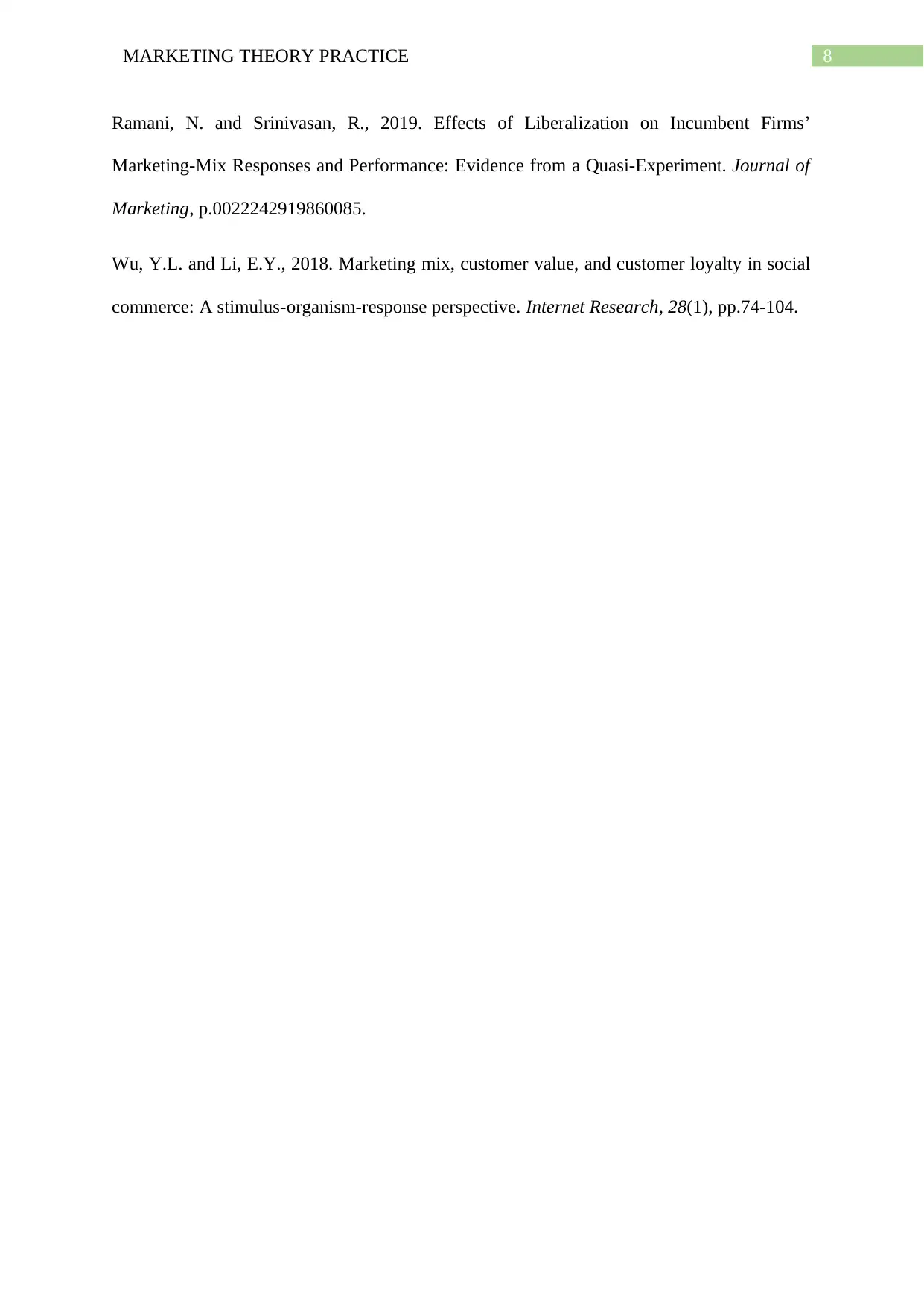
8MARKETING THEORY PRACTICE
Ramani, N. and Srinivasan, R., 2019. Effects of Liberalization on Incumbent Firms’
Marketing-Mix Responses and Performance: Evidence from a Quasi-Experiment. Journal of
Marketing, p.0022242919860085.
Wu, Y.L. and Li, E.Y., 2018. Marketing mix, customer value, and customer loyalty in social
commerce: A stimulus-organism-response perspective. Internet Research, 28(1), pp.74-104.
Ramani, N. and Srinivasan, R., 2019. Effects of Liberalization on Incumbent Firms’
Marketing-Mix Responses and Performance: Evidence from a Quasi-Experiment. Journal of
Marketing, p.0022242919860085.
Wu, Y.L. and Li, E.Y., 2018. Marketing mix, customer value, and customer loyalty in social
commerce: A stimulus-organism-response perspective. Internet Research, 28(1), pp.74-104.
⊘ This is a preview!⊘
Do you want full access?
Subscribe today to unlock all pages.

Trusted by 1+ million students worldwide
1 out of 9
Related Documents
Your All-in-One AI-Powered Toolkit for Academic Success.
+13062052269
info@desklib.com
Available 24*7 on WhatsApp / Email
![[object Object]](/_next/static/media/star-bottom.7253800d.svg)
Unlock your academic potential
Copyright © 2020–2025 A2Z Services. All Rights Reserved. Developed and managed by ZUCOL.



